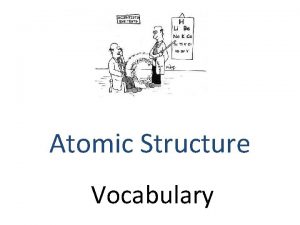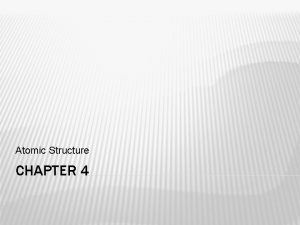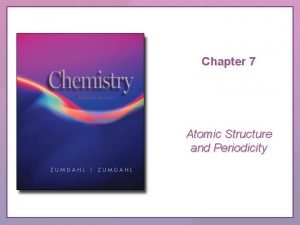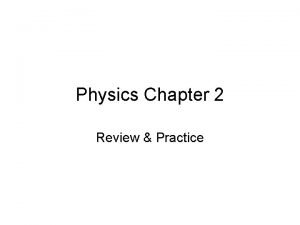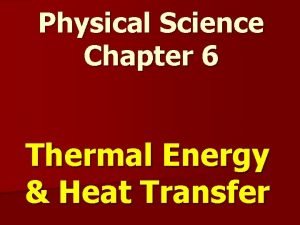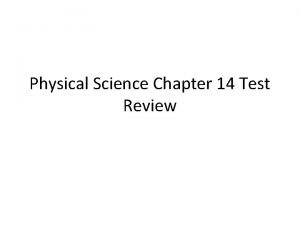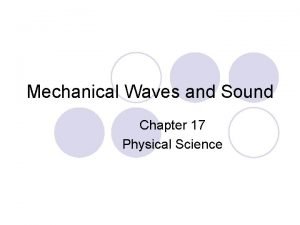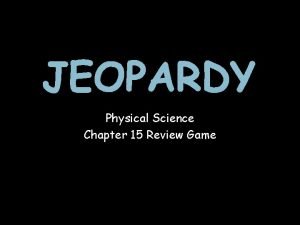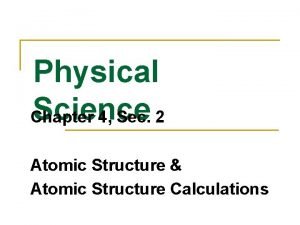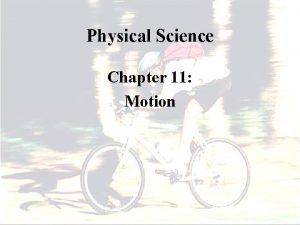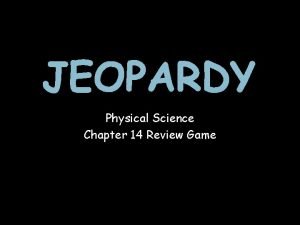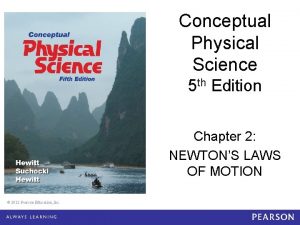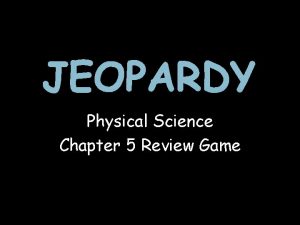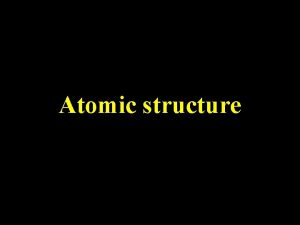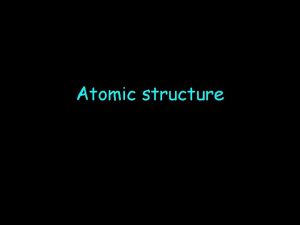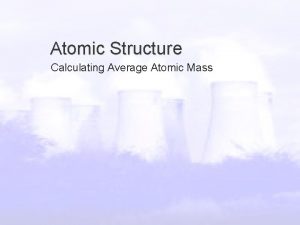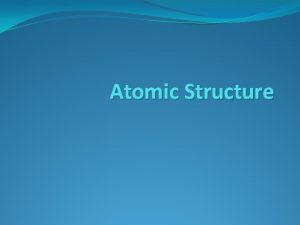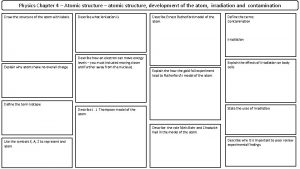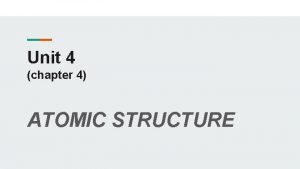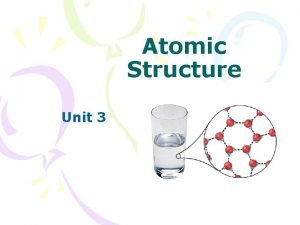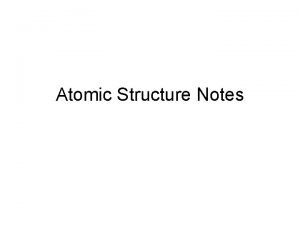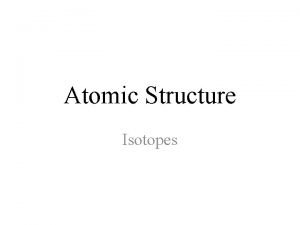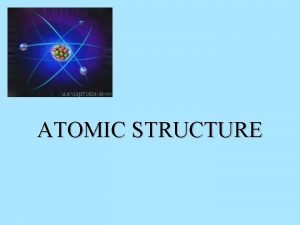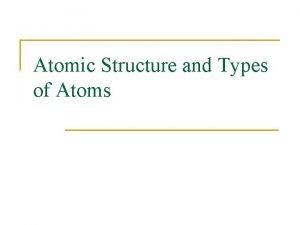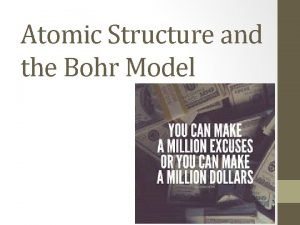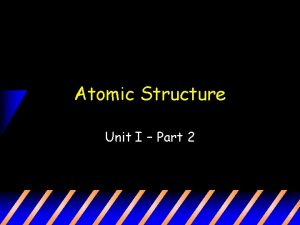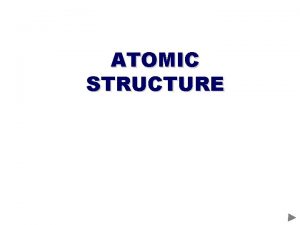Physical Science Chapter 4 Atomic Structure 4 1























- Slides: 23

Physical Science Chapter 4 Atomic Structure

4. 1 Studying Atoms � Democritus and Aristotle ◦ Democritus thought all matter consisted of extremely tiny particles that could not be divided. (Cut aluminum foil in half) ◦ Also thought matter in liquids was round and smooth; in solids rough and prickly ◦ Aristotle thought there was no limit to the number of times matter could be divided.

Dalton’s Atomic Theory � Developed a theory to explain why the elements in a compound always behave in the same way. � Main Points ◦ 1) All elements are composed of atoms. ◦ 2) All atoms of the same element have the same mass, and atoms of different elements have different masses. ◦ 3) Compounds contain atoms of more than one element. ◦ 4) In a compound, atoms of different elements always combine in the same way.

Thomson’s Model � Used a cathode ray tube to show evidence for subatomic, charged particles.

Thomson continued � Plum pudding model (chocolate chip ice cream. � Negatively charged particles evenly spaced throughout a solid mass of positive charge.

Rutherford’s Atomic Theory � The Gold Foil Experiment – Evidence for a nucleus.

Chapter 4 Lesson 2 “Structure of the Atom”

I. Subatomic Particles A. An atom 1. smallest part of matter 2. Ripping paper example B. Areas of an atom 1. Nucleus – center of an atom -holds protons and neutrons a. Protons (P) – positively charged particle found in the nucleus. -has a mass of 1 -has a charge of 1+

b. Neutrons (N) – non-charged particle found in the nucleus. -has a mass of 1 -has no charge “ 0” 2. Electron Cloud – area around the nucleus which contains electrons a. Electrons (e) – negatively charged particle found outside of the nucleus -has a mass of 0 -has a charge of 1 -moves around the outside of the nucleus

Neutrons Protons Electrons

Particles in an Atom Review Particle Mass Charge Location of particle Proton 1 1+ nucleus Neutron 1 0 nucleus Electron 0 1 - Electron cloud

II. Atomic Number A. Def – the # of protons in an atom’s nucleus. 1. Every carbon atom has 6 protons… 2. Every neon atom has 10 protons… B. On P. T. – located right above the chemical symbol *Protons dictate the type of element we have* *Electrons always equal the # of protons*


III. Mass Number A. Def – The sum of protons and neutrons in the nucleus of an atom. 1. On P. T. – bottom number -round up/down 2. Ex: What is the mass number of the following elements? Carbon 12 Oxygen 16 Iron 56 Calcium 40 Sodium 23 Zinc 65

3. Mass # = Protons + Neutrons 4. How many Neutrons on average are found in the following elements? Boron 6 Fluorine 10 Silicon 14 Copper 35 Silver 61 Gold 118

IV. Isotope A. Def – An atom that has a different number of neutrons. 1. Does not affect the element This means 2. Only changes the weight of the element the mass # 3. Ex: Boron-10 and Boron-11 5 protons ppppp nnnnn 5 neutrons Boron-10 ppppp nnnnn n Boron-11 6 neutrons

4. How many neutrons do the following isotopes have? Oxygen-14 6 Titanium-50 28 Magnesium-22 10 Potassium-43 24 Aluminum-23 10 Iodine-130 77

III. Average Atomic Mass A. Def – average mass of all isotopes of one element combined. 1. Found on P. T. underneath chemical symbol. 2. Ex: Carbon = 12. 011 “Carbon has 3 known isotopes. Carbon-12, 13, and 14. Carbon-12 makes up 99% of all carbon on earth. Carbon-13 and 14 make up 1%. ”

Chapter 4 Lesson 3 “Modern Atomic Theory” Chemistry Timeline…pg. 114 -115

I. Bohr’s Model / Energy Levels A. Def – a specific area where an electron is likely to be. e- e- ee- e- 18 electrons eeeeee e- eee- eeee ee- eeee- e e 32 electrons e e 8 electrons eeeee- e- eeeenucleus ee- e 2 electrons

Electrons in Energy Levels Energy Level Maximum # of Electrons 1 2 2 8 3 18 4 32

In Class Assignment 1. Draw a picture of the following atoms with the correct number of e’s, p’s, and n’s… a. Na d. He b. Al e. C c. K f. S 2. Assign: Read pg. 118 and 119 3. What is the difference between a ground state and an excited state?

 Relative formula mass of hcl
Relative formula mass of hcl Periodic table tremds
Periodic table tremds Radius of lithium
Radius of lithium Mass of oxygen
Mass of oxygen Atomic
Atomic Atomic number vs atomic radius
Atomic number vs atomic radius Mind map main branches of science
Mind map main branches of science Natural and physical science
Natural and physical science What s your favorite subject
What s your favorite subject Chapter 4 atomic structure vocabulary
Chapter 4 atomic structure vocabulary Chapter 4 atomic structure
Chapter 4 atomic structure Ap chemistry chapter 7 atomic structure and periodicity
Ap chemistry chapter 7 atomic structure and periodicity Chapter 7 atomic structure and periodicity
Chapter 7 atomic structure and periodicity Glencoe physical science chapter 2 review answers
Glencoe physical science chapter 2 review answers Chapter 6 physical science
Chapter 6 physical science Chapter 14 test physical science
Chapter 14 test physical science Chapter 17 physical science
Chapter 17 physical science Physical science jeopardy
Physical science jeopardy Chapter 4 review physical science
Chapter 4 review physical science Chapter 11 physical science
Chapter 11 physical science Chapter 14 review physical science
Chapter 14 review physical science Conceptual physical science practice sheet chapter 2
Conceptual physical science practice sheet chapter 2 Physical science chapter 5 review
Physical science chapter 5 review As your room gets messier day by day, entropy is
As your room gets messier day by day, entropy is









